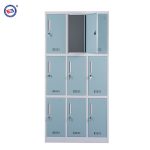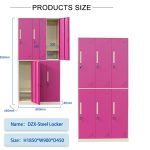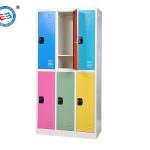Gym lockers are not just a space for storing clothes but also a "temporary safe" for personal belongings. However, thefts from lockers occur from time to time, affecting user experience and potentially harming the gym’s reputation. This article offers practical anti-theft solutions from the perspectives of users and gym owners, ensuring a safer workout experience.
User Guide: Proactive Measures to Prevent Theft
1. Choose Locks Wisely: Don’t Let Convenience Compromise Security
Avoid Basic Combination Locks: Cheap 3-digit locks are vulnerable to brute-force attacks. Opt for 4-digit combination locks.
Beware of "Lock Illusion": Thieves target lockers with loose or missing locks. Ensure your lock fully secures the locker door, avoiding half-fastened setups.
2. Smart Storage: Don’t Turn Lockers into Treasure Chests
Keep Valuables Close: Store phones, wallets, or keys in a waterproof sports waist bag or use gym-provided mini lockboxes (available near workout stations).
Spread the Risk: If you must use a locker, split cash into different pockets and leave jewelry at home. Store IDs or passports at the front desk.
3. Habits Matter: Small Actions, Big Impact
Avoid Blind Spots: Choose lockers near security cameras or within staff sightlines—thieves avoid well-monitored areas.
Minimize Storage Time: Retrieve items immediately after workouts to reduce exposure.
Stay Discreet: Avoid flaunting valuables in locker rooms, and shield the keypad when entering combinations.


Gym Owner Guide: Systematic Solutions for Enhanced Security
1. Hardware Upgrades: Tech-Driven Defense
Smart Locker Systems:
Dynamic Code Locks: Generate unique access codes (e.g., via QR scans) to prevent code theft.
Digital Monitoring: Track locker usage times and user data for post-theft investigations.
Space Optimization:
Separate locker areas from changing rooms, using single-entry pathways and wide-angle cameras.
Install reinforced metal lockers with tamper-proof hinges.
2. Service Protocols: Build Trust Through Policy
Clear Liability Clauses:
State in membership agreements that “lockers are for temporary use; valuables should be stored at the front desk” to avoid legal disputes.
Regular Inspections:
Staff should patrol locker areas hourly to check for unlocked or tampered doors.
Clear abandoned items daily, logging them in a lost-and-found system.
3. User Education: Cultivate Safe Habits
Post anti-theft signage (e.g., “No Cash Storage” icons) and play audio reminders in locker rooms.
Offer free lock trials for new members, demonstrating proper locking techniques.
Case Studies: Win-Win Strategies for Gyms
User-Centric Innovation: A gym chain introduced smart lockers + rental safes, allowing members to reserve VIP locker zones with private safes via an app ($10/month). Member satisfaction rose by 40%.
Owner Success Story: A community gym installed facial recognition alerts in locker areas, triggering staff notifications when non-members entered. Theft rates dropped by 90%, boosting membership renewals.
Conclusion: Safety is the Invisible Shield of the Fitness Experience
For users, vigilance and smart habits are key. For owners, security investments are long-term brand differentiators. By merging technology upgrades with user education, gyms can minimize losses while fostering trust—because no one should worry about their wallet while chasing personal bests.
Pro Tip: Before your next workout, spend 60 seconds reviewing your lock and storage strategy. Your caution is the ultimate anti-theft system.





